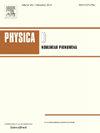旱地资源消耗动态:用分段系统模拟植物-植物促进-竞争转变的作用
IF 2.9
3区 数学
Q1 MATHEMATICS, APPLIED
引用次数: 0
摘要
在旱地,水的可用性决定了植物的种群密度,以及它们是通过促进还是竞争来合作。当缺水加剧时,植物密度下降,对水的竞争超过了促进植物改善土壤的好处,涉及从促进到竞争的突然转变。在这里,我们使用资源物种(如草)的分段系统来模拟这种促进-竞争转变,研究其对资源消耗动力系统的影响。首先,每个系统的动态,即竞争和合作,分别介绍了这个资源消耗系统。竞争系统通过设定条件使其在第一象限达到单峰均衡,因而没有极限环。在同一象限的单态条件下,合作系统只有一个双曲的、小振幅的极限环,允许振荡共存。分段系统的动态特性变得更加丰富。在这种特殊情况下,我们证明了中心焦点问题的推广,并从一个3阶的弱焦点中,得到了由它产生的3个极限环。我们还研究了在分段系统中假设连续性的情况。最后,给出了伪hopf分岔型的小幅极限环的一种特殊的受限方法。我们的研究结果表明,突变的密度依赖的功能转移,如在旱地所描述的,可能会在种群动态中引入新的动态现象。我们的工作还提供了一个新的理论框架来模拟和研究种群动态,其中生态相互作用由于密度依赖效应而变化。本文章由计算机程序翻译,如有差异,请以英文原文为准。
Resource-consumer dynamics in drylands: Modeling the role of plant–plant facilitation–competition shifts with a piecewise system
In drylands, water availability determines plant population densities and whether they cooperate via facilitation or compete. When water scarcity intensifies, plant densities decrease and competition for water surpasses the benefits of soil improvement by facilitator plants, involving an abrupt shift from facilitation to competition. Here, we model this facilitation–competition shift using a piecewise system in a resource species such as grasses studying its impact on a resource-consumer dynamical system. First, the dynamics of each system i.e., competitive and cooperative, are introduced separately for this resource-consumer system. The competitive system, by setting conditions to have a monodromic equilibrium in the first quadrant, has no limit cycles. With a monodromy condition in the same quadrant, the cooperative system only has a hyperbolic, small amplitude limit cycle, allowing for an oscillating coexistence. The dynamic properties of the piecewise system become richer. We here prove the extension of the center-focus problem in this particular case, and from a weak focus of order three, we find 3 limit cycles arising from it. We also study the case assuming continuity in the piecewise system. Finally, we present a special and restricted way of obtaining a limit cycle of small amplitude in a pseudo-Hopf bifurcation type. Our results suggest that abrupt density-dependent functional shifts, such as those described in drylands, could introduce novel dynamical phenomena in population dynamis. Our work also provides a novel theoretical framework to model and investigate population dynamics where ecological interactions change due to density-dependent effects.
求助全文
通过发布文献求助,成功后即可免费获取论文全文。
去求助
来源期刊

Physica D: Nonlinear Phenomena
物理-物理:数学物理
CiteScore
7.30
自引率
7.50%
发文量
213
审稿时长
65 days
期刊介绍:
Physica D (Nonlinear Phenomena) publishes research and review articles reporting on experimental and theoretical works, techniques and ideas that advance the understanding of nonlinear phenomena. Topics encompass wave motion in physical, chemical and biological systems; physical or biological phenomena governed by nonlinear field equations, including hydrodynamics and turbulence; pattern formation and cooperative phenomena; instability, bifurcations, chaos, and space-time disorder; integrable/Hamiltonian systems; asymptotic analysis and, more generally, mathematical methods for nonlinear systems.
 求助内容:
求助内容: 应助结果提醒方式:
应助结果提醒方式:


